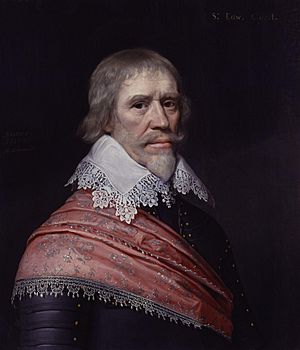Edward Cecil, 1st Viscount Wimbledon facts for kids
Edward Cecil, 1st Viscount Wimbledon (born 1572 – died 1638) was an important English military leader and politician. He served in the English Parliament, known as the House of Commons, at different times between 1601 and 1624.
Contents
Edward Cecil's Life and Career
Edward Cecil was the third son of Thomas Cecil, the 1st Earl of Exeter. His grandfather was William Cecil, 1st Baron Burghley, a very important minister to Queen Elizabeth I.
Early Military Service
Edward Cecil began his military career in the Netherlands in 1596. He fought with English forces there until 1610. By 1599, he became a captain. In 1600, he led a cavalry troop at the battle of Nieuport. He fought under Sir Francis Vere, another famous English commander.
In 1601, Cecil led a group of a thousand men from London. Their mission was to help the city of Ostend, which was under attack by the Spanish. When he returned in September, Queen Elizabeth knighted him. This meant he was now called "Sir Edward Cecil."
Parliament and Further Campaigns
In 1601, Edward Cecil was elected as a Member of Parliament (MP) for Aldborough. This meant he represented that area in the House of Commons.
In 1602, he became a colonel of an English cavalry regiment. He served under Prince Maurice and fought in the Siege of Grave. In 1604, he led the English cavalry during the capture of Sluis. He helped defeat a Spanish attempt to rescue the city.
Cecil continued to serve actively and became known as a skilled soldier. In 1610, he commanded British and Irish soldiers. They served under Prince Christian of Anhalt in the War of the Jülich succession. They fought at the siege of Juliers. This was the first time an army flew the Union Flag as a "British" army.
Court Life and Political Roles
Edward Cecil was also well-regarded at court. In 1612, he represented the prince at a special event. He was a sponsor at the baptism of Henry Casimir, the son of Count Ernest of Nassau. Cecil gave many valuable gifts, including gold plates and a diamond necklace.
In 1621, he was elected MP for Chichester. He strongly supported helping the Palatinate region in Germany. This was during the early stages of the Thirty Years' War. He said that supporting them would be more helpful than having ten thousand soldiers. In 1624, he was elected MP for Dover.
Later Military Commands
In 1625, Cecil was put in charge of a military trip to Spain. This was called the attack on Cadiz. The main goal was to capture Spanish treasure ships. However, the attack did not go as planned, and they missed the ships.
Even though the mission failed, Edward Cecil was honored. In November 1625, he was given two noble titles: Baron Cecil of Putney and Viscount Wimbledon. These titles were named after his home, Wimbledon House in Surrey.
He continued to lead English forces in the Netherlands from 1627 to 1629. He was involved in the Siege of Groenlo and the Siege of 's-Hertogenbosch. He also served as the Lord Lieutenant of Surrey from 1627 to 1638. From 1630 to 1638, he was the Governor of Portsmouth, an important military port. He remained a highly respected figure in the military.
Edward Cecil's Family Life
Edward Cecil married three times during his life.
His first marriage was in 1601 to Theodosia Noel. They had five daughters: Dorothy, Albinia, Elizabeth, Frances, and Utriche.
After Theodosia passed away, he married Diana Drury in 1618. They had one child, Anne, who died when she was very young.
In 1635, Cecil married for the third time to Sophia Zouche. They had a son named Algernon, but he also died when he was less than a year old.
Edward Cecil, the 1st Viscount Wimbledon, died in 1638. He was buried in the Cecil Chapel at St Mary's Church, Wimbledon. Since he had no children who lived to inherit his titles, both his titles ended when he died. His wife, Sophia, later remarried.
See also
- Wimbledon Palace – Edward Cecil's home, which was built by his father Sir Thomas Cecil in 1588.



